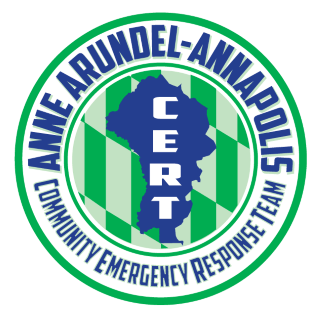Dates for both July and September have been released and registration is open!
Schedule for Summer:
Friday, July 28: 6pm-9pm
Saturday, July 29: 8am-5pm
Sunday, July 30: 8am-3pm
Saturday, August 5: 8am-1pm (disaster simulation)
Click here to register for the summer session!
Schedule for Fall:
Friday, September 15: 6pm-9pm
Saturday, September 16: 8am-5pm
Sunday, September 17: 8am-3pm
Sunday, September, September 24: 8am-1pm (disaster simulation) (This is a change from the previously published date of Saturday, September 23).
Click here to register for the fall session!
Anne Arundel County Fire Training Academy
415 Maxwell Frye Road
Millersville, MD 21108
CERT Basic Training is designed to prepare you to help yourself and to help others in the event of a catastrophic disaster. Because emergency services personnel will not be able to help everyone immediately, you can make a difference by using your CERT training to save lives and protect property. This training covers basic skills that are important to know in a disaster when emergency services are not available. With training and practice, and by working as a team, you will be able to protect yourself and do the greatest good for the greatest number after a disaster.
The purpose of the Community Emergency Response Team (CERT) Basic Training is to provide the individuals who complete this course with the basic skills that they will need to respond to their community’s immediate needs in the aftermath of a disaster, when emergency services are not immediately available. By working together, CERT members can assist in saving lives and protecting property using the basic techniques in this course. The target audience for this course is individuals who desire the skills and knowledge required to prepare for and respond to a disaster. Medical or EMT experience is not required.
Fee: $70.00 to cover the cost of the training manual, disposable first aid training supplies, and a CERT backpack.
Lunch: On your own – suggest that you bring a bag lunch however, there are several fast food restaurants nearby.
Attendees are required to attend all sessions to complete the class and obtain a certificate. For questions, please contact training@aaacert.org
Overall Course Objectives
Upon completing this course, the participants should be able to:
- Describe the types of hazards that are most likely to affect their homes, workplaces, and neighborhoods.
2. Take steps to prepare themselves and their families for a disaster.
3. Describe the functions of CERTs and their role in immediate response.
4. Identify and reduce potential fire hazards in their homes, workplaces, and neighborhoods.
5. Work as a team to apply basic fire suppression strategies, resources, and safety measures to extinguish a pan fire.
6. Apply techniques for opening airways, controlling excessive bleeding, and treating for shock.
7. Conduct triage under simulated disaster conditions.
8. Perform head-to-toe patient assessments.
9. Select and set up a treatment area.
10.Employ basic treatments for various injuries and apply splints to suspected fractures and sprains.
11.Identify planning and sizeup requirements for potential search and rescue situations.
12.Describe the most common techniques for searching a structure.
13.Work as a team to apply safe techniques for debris removal and victim extrication.
14.Describe ways to protect rescuers during search and rescue operations.
15.Describe the post-disaster emotional environment and the steps that rescuers can take to relieve their own stressors and those of disaster survivors.
16.Describe CERT organization and documentation requirements. In addition to the overall course objectives listed above, each unit has specific objectives.
Course Outline
Unit – 1 Disaster Preparedness
– Introductions and Overview
– Community Preparedness: Roles and Responsibilities
– Hazards and Their Potential Impact
– Impact on the Infrastructure
– Home and Workplace Preparedness
– Reducing the Impact of Hazards Through Mitigation
– CERT Disaster Response
– Protection for Disaster Workers
– Additional Training for CERTs
– Unit Summary
Unit – 2 Fire Safety and Utility Controls
– Introduction and Unit Overview
– Fire Chemistry
– Fire and Utility Hazards
– CERT Sizeup
– Fire Sizeup Considerations
– Firefighting Resources
– Fire Suppression Safety
– Hazardous Materials
– Exercise: Suppressing Small Fires
– Unit Summary
Unit – 3 Disaster Medical Operations — Part 1
– Introduction and Unit Overview
– Treating Life-Threatening Conditions
– Triage
– Unit Summary
Unit – 4 Disaster Medical Operations — Part 2
– Introduction and Unit Overview
– Public Health Considerations
– Functions of Disaster Medical Operations
– Establishing Medical Treatment Areas
– Conducting Head-to-Toe Assessments
– Treating Burns
– Wound Care
– Treating Fractures, Dislocations, Sprains, and Strains
– Nasal Injuries
– Treating Cold-Related Injuries
– Treating Heat-Related Injuries
– Bites and Stings
– Unit Summary
Unit – 5 Light Search and Rescue Operations
– Introduction and Unit Overview
– Safety During Search and Rescue Operations
– Conducting Interior and Exterior Search Operations
– Conducting Rescue Operations
– Unit Summary
Unit – 6 CERT Organization
– Introduction and Unit Overview
– CERT Organization
– CERT Mobilization
– Documentation
– Activity: ICS Functions
– Activity: Tabletop Exercise
– Unit Summary
Unit – 7 Disaster Psychology
– Introduction and Unit Overview
– Disaster Trauma
– Team Well-Being
– Working with Survivors’ Trauma
– Unit Summary
Unit – 8 Terrorism and CERT
– Introduction and Unit Overview
– What Is Terrorism?
– Terrorist Targets
– Terrorist Weapons
– CBRNE Indicators
– Preparing at Home, Work, and in Your Neighborhood
– CERTs and Terrorist Incidents
– Activity: Applying CERT Principles to a Suspected Terrorist Incident
– Unit Summary
Unit – 9 Functional Needs, Course Review, Final Exam, and Disaster Simulation
– Introduction and Unit Overview
– Course Review
– Final Exam
– Disaster Simulation
Exercise Critique and Summary
We look forward to having you!
Course dates/times/content subject to change. Changes will be made on this blog post.
